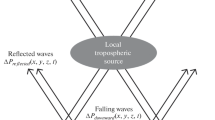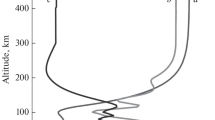Abstract
Experimental data on variations in atmospheric surface pressure in the region of thunderstorm phenomena are analyzed. A relationship between variations in atmospheric pressure at the land surface and those in tropospheric temperature has been found, and the relation between the vertical distribution of tropospheric temperature and variations in atmospheric pressure at the land surface is studied. The propagation of internal gravity waves caused by atmospheric heating due to water-vapor condensation during the formation of a convective cloud is simulated. The results of calculations show that the lifetime of these internal gravity waves may significantly exceed the lifetime of this cloud. It is shown that the form of the disturbance of atmospheric pressure under such a convective cloud is a sequence of minimum and maximum pressure variations and the amplitude of maxima may exceed that of minima.
Similar content being viewed by others
References
A. D. Pierce and S. C. Coroniti, “A mechanism for the generation of acoustic-gravity waves during thunderstorm formation,” Nature 210, 1209–1210 (1966). doi: 10.1038/2101209a0
N. K. Balachandran, “Gravity waves from thunderstorms,” Mon. Weather Rev. 108, 804–816 (1980).
G. I. Grigor’ev and V. P. Dokuchaev, “Infrasound and internal gravity waves during lightning discharges in the atmosphere,” Izv. Akad. Nauk SSSR, Fiz. Atmos. Okeana 17(7), 690–697 (1981).
V. I. Ermakov and Yu. I. Stozhkov, Physics of Thunderstorm Clouds (FIAN, Moscow, 2004) [In Russian].
M. Alexander, P. May, and J. Beres, “Gravity waves generated by convection in the Darwin area during the Darwin Area Wave Experiment,” J. Geophys. Res. 109(D20S04), 1–11 (2004).
D. V. Miller, “Thunderstorm induced gravity waves as a potential hazard to commercial aircraft,” in Proc. of the 79th Annual Conference American Meteorological Society (Dallas, 1999).
G. S. Lehmiller, H. B. Bluestein, P. J. Neiman, F. M. Ralf, and W. F. Feltz, “Wind structure in a supercell thunderstorm as a measured by a UHF wind profiler,” Mon. Weather Rev. 129, 1968–1986 (2001).
J. B. Snively and V. B. Pasko, “Breaking of thunderstorm-generated gravity waves as a source of short-period ducted waves at mesopause altitudes,” Geophys. Res. Lett. 30(24), 2254 (2003). doi: 10.1029/2003GL018436
E. Blanc, T. Farges, and A. Le Pichon, “Gravity waves driven by thunderstorms,” in Proc. of the First ARISE Workshop (University of Reading, 2012), p. 16.
N. M. Gavrilov and S. P. Kshevetskii, “Numerical modeling of propagation of breaking nonlinear acoustic-gravity waves from the lower to the upper atmosphere,” Adv. Space Res. 51(7), 1168–1174 (2013).
R. Fovell, D. Durran, and J. R. Holton, “Numerical simulation of convectively generated stratospheric gravity waves,” J. Atmos. Sci. 47, 1427–1442 (1992).
R. H. Jonson and G. S. Young, “Heat and moisture budgets of tropical mesoscale anvil clouds,” J. Atmos. Sci. 80, 2138–2147 (1983).
F. T. São Sabbas, V. T. Rampinelli, J. Santiago, et al., “Characteristics of sprite and gravity wave convective sources present in satellite IR images during the SpreadFEx 2005 in Brazil,” Ann. Geophys. 27, 1279–1293 (2009).
A. Le Pichon, “Global-scale stratospheric process as measured by the infrasound IMS network,” Proc. of the First ARISE Workshop (University of Reading, 2012), p. 29.
Author information
Authors and Affiliations
Corresponding author
Additional information
Original Russian Text © S.P. Kshevetskii, S.N. Kulichkov, 2015, published in Izvestiya AN. Fizika Atmosfery i Okeana, 2015, Vol. 51, No. 1, pp. 52–59.
Rights and permissions
About this article
Cite this article
Kshevetskii, S.P., Kulichkov, S.N. Effects that internal gravity waves from convective clouds have on atmospheric pressure and spatial temperature-disturbance distribution. Izv. Atmos. Ocean. Phys. 51, 42–48 (2015). https://doi.org/10.1134/S0001433815010065
Received:
Accepted:
Published:
Issue Date:
DOI: https://doi.org/10.1134/S0001433815010065




